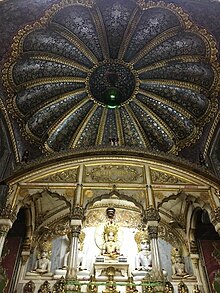
Summary
Sumatinatha was the fifth Jain Tirthankara of the present age (Avasarpini). Sumatinatha was born to a Kshatriya King Megha (Megharatha) and Queen Mangalavati (Sumangalavati) at Ayodhya in the Ikshvaku dynasty. His Janma Kalyanak (birthday) was the eighth day of the Vaisakha Sudi month of the Jain calendar.
| Sumatinatha | |
|---|---|
5th Jain Tirthankara | |
 Lord Sumatinatha at Naughara Jain Temple Chandni Chowk Delhi | |
| Venerated in | Jainism |
| Predecessor | Abhinandananatha |
| Successor | Padmaprabha |
| Symbol | Goose |
| Height | 300 bows (900 meters) |
| Age | 4,000,000 purva (282.24 Quintillion Years Old) |
| Tree | Priyangu |
| Color | Golden |
| Personal information | |
| Born | |
| Died | |
| Parents |
|
Tradition edit
Sumatinatha was the fifth Jain Tirthankara of the present age (Avasarpini).[1] Sumatinatha was born to Kshatriya King Megha (Meghaprabha) and Queen Mangala (Sumangala) at Ayodhya in the Ikshvaku dynasty. His birth date was the eighth day of the Vaisakha Sudi month of the Jain calendar.[1]
He attained Kevala Jnana under sala or priyangu tree.[2] He became a siddha, a liberated soul which has destroyed all of its karma. Lord Sumithanatha is associated with Heron (Krauncha) emblem, Priyangu tree, Tumburu (Purushadatta) Yaksha and Mahakala Yakshi.[3]
In his previous incarnation, Lord Sumatinatha was an Indra in the Jayanta Vimana.[4]
Adoration edit
Svayambhustotra by Acharya Samantabhadra is the adoration of twenty-four tirthankaras. Its five slokas (aphorisms) are dedicated to Sumatinātha.[5] Last of which is:
The attributes of existence and non-existence in an object are valid from particular standpoints; the validity of the statement is contingent on the speaker's choice, at that particular moment, of the attribute that he wishes to bring to the fore as the other attribute is relegated to the background. O Lord Sumatinātha, you had thus explained the reality of substances; may your adoration augment my intellect![6]
Main temples edit
-
Bhandasar Jain Temple
-
Main vedi of Bhandasar Jain Temple
-
Paintings in Bhandasar Jain Temple
See also edit
Notes edit
- ^ a b Tukol 1980, p. 31.
- ^ Krishna & Amirthalingam 2014, p. 46.
- ^ Tandon 2002, p. 44.
- ^ Umakant P. Shah 1987, p. 136.
- ^ Vijay K. Jain 2015, p. 28-35.
- ^ Vijay K. Jain 2015, p. 35.
References edit
- Johnson, Helen M. (1931), Sumatinathacaritra (Book 3.3 of the Trishashti Shalaka Purusha Caritra), Baroda Oriental Institute
- Jain, Vijay K. (2015), Acarya Samantabhadra's Svayambhustotra: Adoration of The Twenty-four Tirthankara, Vikalp Printers, ISBN 978-81-903639-7-6, archived from the original on 16 September 2015,
This article incorporates text from this source, which is in the public domain.
- Krishna, Nanditha; Amirthalingam, M. (2014) [2013], Sacred Plants of India, Penguin Books, ISBN 978-9-351-18691-5
- Shah, Umakant Premanand (1987), Jaina-rūpa-maṇḍana: Jaina iconography, Abhinav Publications, ISBN 81-7017-208-X
- Tandon, Om Prakash (2002) [1968], Jaina Shrines in India (1 ed.), New Delhi: Publications Division, Ministry of Information and Broadcasting, Government of India, ISBN 81-230-1013-3
- Tukol, T. K. (1980), Compendium of Jainism, Dharwad: University of Karnataka


